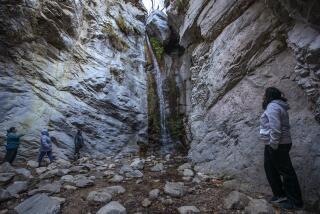Obama administration proposes new planning rule for national forests
Federal supervisors would have to run the country’s national forests to maintain ecological health and species diversity under a proposed Obama administration rule that also requires them to prepare environmental reviews when they update forest management plans.
The 94-page document is the latest version of a forest planning rule that has gone through a decade of revision and litigation as changing administrations left their stamps on it. It would shape the future of the 193-million-acre national forest system, including more than 20 million acres in California.
The Bush administration rules, widely criticized for eliminating long-standing wildlife protections, were set aside by the courts, leaving in place management blueprints first adopted under President Reagan.
Agriculture Secretary Tom Vilsack described the Obama administration’s proposal, released Thursday, as an attempt to strike a balance that would promote ecological diversity and protect wildlife but also recognize recreational needs and economic demands such as logging on the 155 forests and 20 grasslands in the national forest system.
“Forests don’t have a single purpose,” he said. “This is not about pitting one use against another.”
Some environmental groups praised the proposed rule as a vast improvement over the Bush regulations. But advocates also complained that it would leave too much wiggle room for local forest supervisors to fudge protections.
“When you get right down to it, there are a lot of ‘mays’ but not that many ‘musts’,” said Jane Danowitz, U.S. public lands director for the Pew Environment Group.
The strongest criticism came from the Defenders of Wildlife, which successfully challenged the Bush rules in court. “We’re disappointed,” said the group’s president, Rodger Schlickeisen. “They do a little thing here or there that’s good. But this is a significant rollback of protections for wildlife and habitat.”
He pointed to changes to a section of the 1982 Reagan rules, which require that national forests be managed to maintain “viable populations” of native and desirable nonnative vertebrate species. That mandate, dropped by Bush, takes a different shape in the Obama rules.
Although forests would have to be managed to protect endangered species and others of concern under the Obama proposal, the emphasis for most forest species would be to maintain a healthy ecosystem that supports diverse plant and wildlife communities.
Joel Holtrop, deputy Forest Service chief, said the directive in some ways “goes beyond” the existing “viable populations” benchmark because it would cover native plants and invertebrates as well.
“If we maintain or restore the structure, the function, the composition of ecosystems and watersheds,” he said, “we’re going to provide for diversity of the vast majority of species.”
The proposal retains a requirement dropped by the Bush administration that supervisors prepare environmental impact statements when they revise management plans for individual forests. Those plans dictate which activities are allowed on every acre, including recreation, logging and mining.
The proposed rule also stresses the importance of protecting watersheds and river and stream banks, which have sometimes been severely damaged by logging operations.
Nathaniel Lawrence, director of the Forest Project at the Natural Resources Defense Council, found “a lot to like” in the document.
“It takes a sober view of the need to restore degraded lands and consider the future effect of major processes like climate change,” he said. He called the proposal “a stark contrast from repeated efforts in the Bush administration to degrade the planning process.”
In an e-mail, Michael Goergen, chief executive of the Society of American Foresters, said the proposed rule appears “to give discretion to land managers and requires significant collaboration with stakeholders. SAF has been calling for these elements in planning for decades. For any forest plan to be successful it must be flexible and adaptable.”
California’s 18 national forests run the length of the state and cover a fifth of its land mass.
The rule will undergo 90 days of public comment and could be modified before it becomes final.
More to Read
Start your day right
Sign up for Essential California for news, features and recommendations from the L.A. Times and beyond in your inbox six days a week.
You may occasionally receive promotional content from the Los Angeles Times.






